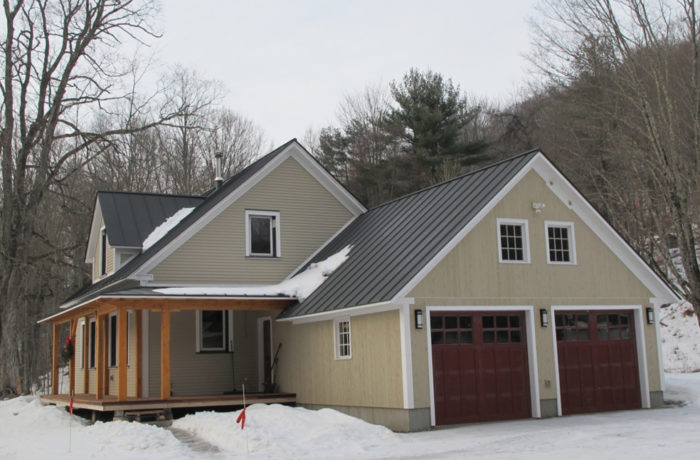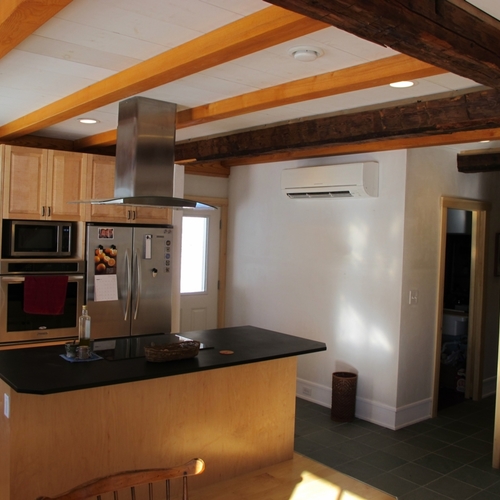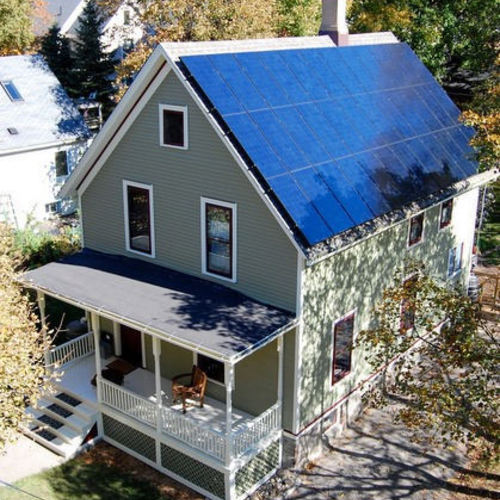Image Credit: Alex Wilson
Image Credit: Alex Wilson We picked up a number of the stair components and some timber framing members from a salvage yard. We saved a lot on mechanical systems by going with a single 18,000 BTU/hour minisplit air-source heat pump instead of a distributed heating system.
My wife and I tried out a lot of innovative systems and materials in the renovation/rebuild of our Dummerston, Vermont home — some of which added considerably to the project cost. Alas!
The induction cooktop that I wrote about last week is just one such example.
For me, the house has been a one-time opportunity to gain experience with state-of-the-art products and technologies, some of which are very new to the building industry (like cork insulation, which was expensive both to buy and to install). We spent a lot experimenting with new materials, construction details, and building systems. While we haven’t tallied up all the costs, we think that the house came in at about $250 per square foot.
All this has raised the very reasonable question about whether all this green-building stuff is only feasible for high-budget projects.
So I’ve been thinking about what lessons from our project would be applicable to more budget-conscious retrofits. Here are some thoughts.
Keep it compact. In renovating the old farmhouse we shrank the footprint, eliminating a kitchen addition that had been added perhaps in the 1920s. Fitting the kitchen into the main house meant some tricky design work, but it helped us contain costs with the exterior envelope and finishes. This cost-saving strategy applies whether with new construction or renovating an existing house. The cost per square foot will likely go up with a smaller house, but the total cost should drop — and there will be less volume to heat and cool.
Deep-energy retrofit with mineral wool. The cork insulation we used as an insulation wrap on the walls was really amazing, and I’m glad we used it, but if we were doing the project over with a more constrained budget, I think I would have gone with rigid mineral wool. Carrying out a deep-energy retrofit by wrapping a house in rigid insulation is never inexpensive and it depends on having deep enough roof overhangs, but with rigid mineral wool (such as Roxul ComfortBoard or the highest-density Thermafiber product) it can be a much more reasonable retrofit.
High-performance storm windows. While our low-emissivity (low-e) storm windows on the south and east facades aren’t installed yet, they can provide a reasonably priced alternative to window replacement with top-performing, triple-glazed windows. The idea is to keep the existing (prime) windows when installing exterior rigid insulation on a house and add window surrounds to extend the window openings to the new outer face of the walls — and then install the storm windows near the outer face of the window surrounds.
Air-source heat pump. The heating system we went with on our house is a great option today for compact, very well insulated homes, while larger, ducted versions of these systems will increasingly make sense for replacing conventional gas or oil heating systems. On a cost per million BTUs of delivered heat basis, air-source heat pumps are significantly less expensive than propane and heating oil, and they can be pretty competitive with natural gas — especially if natural gas prices keep climbing. An air-source heat pump means electric heat, but that opens the door to generating the electricity you need — now or down-the-road — with a photovoltaic system.
Water-efficient products. We went with state-of-the-art water-conserving plumbing fixtures and appliances. The 1.75 gallon-per-minute Kohler WaterSense showerheads in our two bathrooms significantly reduce hot water use, compared with standard 2.5 gpm models, saving energy as well as water. And they don’t cost any more than standard models.
Rainscreen detail on exterior walls. We spent a little more installing strapping over the exterior sheathing so that the siding will have an air space behind it, but the cost is low enough and the durability benefits great enough that this should be standard practice today. We will save thousands of dollars over the years by having to paint the siding only every 15-20 years (I predict), instead of as often as every five years, and a big part of the difference is the rainscreen detail.
Salvaged materials. We were able to save some money — and with more concerted effort, could have saved a lot more — by making use of salvaged materials. We bought a salvaged newel post and balustrades for the stairs, for example, picked up a discontinued floor-demo front door, purchased salvaged timbers for post replacements in the barn, and bought superb two garage doors from the now (sadly) closed ReNew Salvage in Brattleboro. Using salvaged materials not only saves money, but it can also help the environment by allowing us to save in raw materials extraction and by reducing pressure on landfills.
Saving resources, saving energy, and saving money when building
These are just a few examples of how a green, energy-efficiency agenda can be achieved with an eye towards economy. Building or renovating with a goal of energy savings and environmental stewardship does not have to have a huge cost impact.
Fundamentally, it’s all about savings — saving energy resources and saving the environment. If we were to put an economic value on protecting the environment, those environmental savings with our house might have compensated for the increased cost of building. But we’re not there yet.
Alex is founder of BuildingGreen, Inc. and executive editor of Environmental Building News. In 2012 he founded the Resilient Design Institute. To keep up with Alex’s latest articles and musings, you can sign up for his Twitter feed.
Weekly Newsletter
Get building science and energy efficiency advice, plus special offers, in your inbox.















10 Comments
Salvage Materials
Good article. I love the idea of buying used materials . Habitat Re-stores and Craigslist-for instance, are good sources. For instance I have even seen rigid foam seconds and even in used condition offered (though I would be concerned about where it came from if an industrial use). Another way to save money (and perhaps materials destined for the landfill) is to buy from builders auctions. Check out "peakauction.com"; lambrecht auctions and aj wilner auctions for example. I have had good luck at peak auctions when they are in the area so long as (i) you go with a plan and a specific list of items, (ii) you know what you are bidding on and price limits, (iii) you inspect before the auction, (iv) stay away from the pretty stuff everyone else is bidding on, and (v) have a truck ready to transport what you buy. Raw materials often go for a fraction of the cost.
doohickey
Not really germane to the article, but what's that doohickey on the gable end of the garage above the right hand window?
Doohickey near the garage peak
David,
You're quite observant!
Those are two 4" vent pipe exhausts: One is the termination of a radon mitigation stack that we installed just in case. There's a lot of granite in the area and high radon levels in many houses, so we installed a system for depressurizing the sub-slab crushed stone if we find high radon levels, and the vent stack terminates at the garage roof. I did fairly extensive radon testing in the basement during construction, and the measured levels were mostly very low, so I don't think we'll have to use that.
The other is the termination of a vent stack for a composting toilet in case we install one down-the-road. We would likely install a urine-separating/composting toilet so that urine could be captured and used on non-food crops on our farm (as being done in some Scandinavian countries--urine contains something like 90% of the nitrogen and 60% of the phosphorous in human waste while none of the pathogens). We don't have immediate plans to install such a toilet, but we planned a space in the basement where the composting tank and urinate-storage tank could go.
In both cases, it would cause a lot of disruption later if had to retrofit ventilation piping through the well-insulated envelope, so we pre-plumbed the ventilation piping.
Alex explain why urine is not used on food crops
"It contains no pathogens" is it just the ick factor? Last year I read about a formula... 6-1 water to urine, let sit for 3 weeks and then it's ready for use. Do a blog on it... or tell us more here.
lots of conversation re urine and handling pathogens....
http://backyardaquaponics.com/forum/viewtopic.php?t=2534
essentially, aging the stuff will kill the little that is in there, so his storage tank will do the job. On the other hand, living on boats I have found that over time scent will come right through plastic....
Collection and use of urine
AJ,
It's mostly the ick factor, but, as Dustin notes, there can be pathogens in urine. There's a project in Brattleboro, Vermont (which has obtained U.S. Department of Agriculture funding) to study this. The Rich Earth Institute (http://richearthinstitute.org/), led by Abe Noe Hays, has been studying urine separation and use on hay fields. They are studying various pasteurization techniques, including use of solar heating to kill any viruses or bacteria that may be in it. Field trials are showing dramatic improvements in hay production.
By contrast, with standard composting toilets, most of the nitrogen is volatilized as either nitrogen gas (N2) or ammonia (NH3) and lost into the air.
Dustin, I browsed your
Dustin, I browsed your link
and I didn't find so far info on my formula that I thought some used, 6-1 water, let sit, then use.
Alex, thank you... I second the motion for a blog done well as to urine fertilizer. One positive is if no one uses a flush toilet for urine the amount of water use goes down substantially. Urine can be flushed with ounces to no water if the right facility is used.
Urine blog.... needed... more info.. point us people
what are the ceiling planks?
what are the ceiling planks? Nice looking home!
Ceiling system
Bob,
That's an access ceiling system with panels about three feet on a side comprised of three short lengths of shiplap pine secured together. With the shiplap, any panels can be lifted out to access light, ventilation, plumbing, etc.
Do you offer house plans? The house itself looks perfect for what my wife and I want to build for us and the one or two kids we plan to have. I'm a solar energy contractor, so the steep roof facing south (assume one side does not have a dormer) would contain a lot of solar modules. Thanks!
Log in or create an account to post a comment.
Sign up Log in